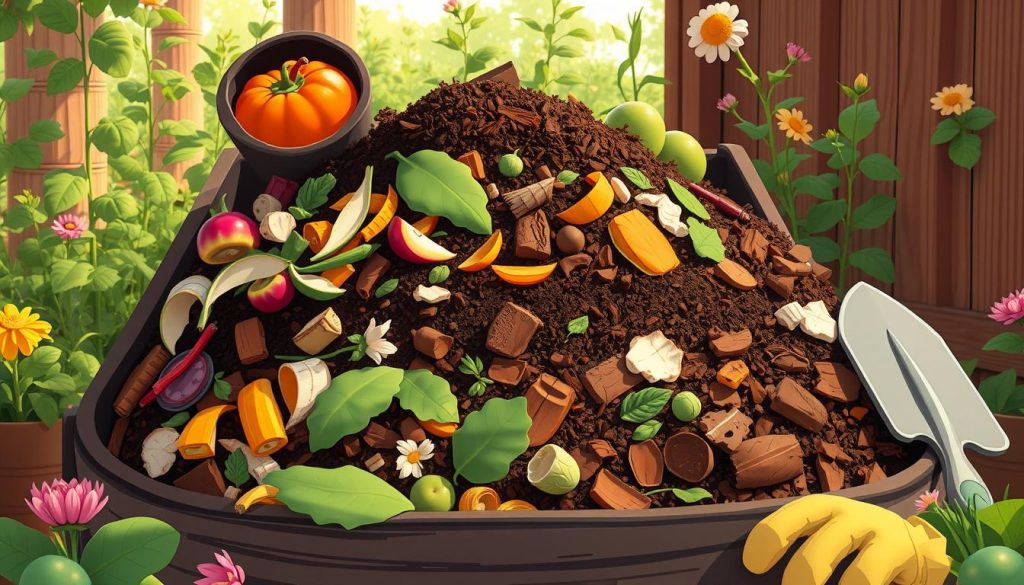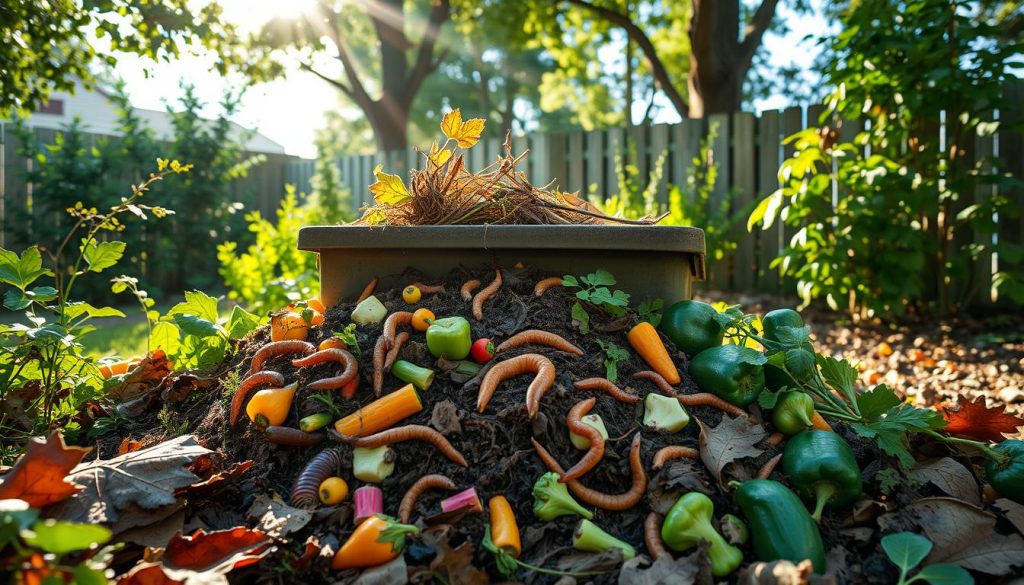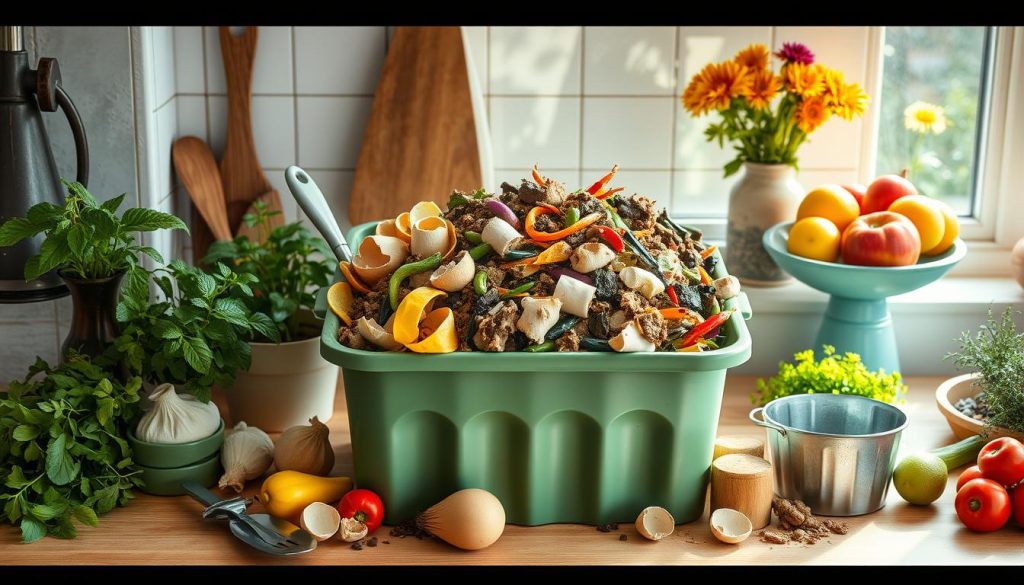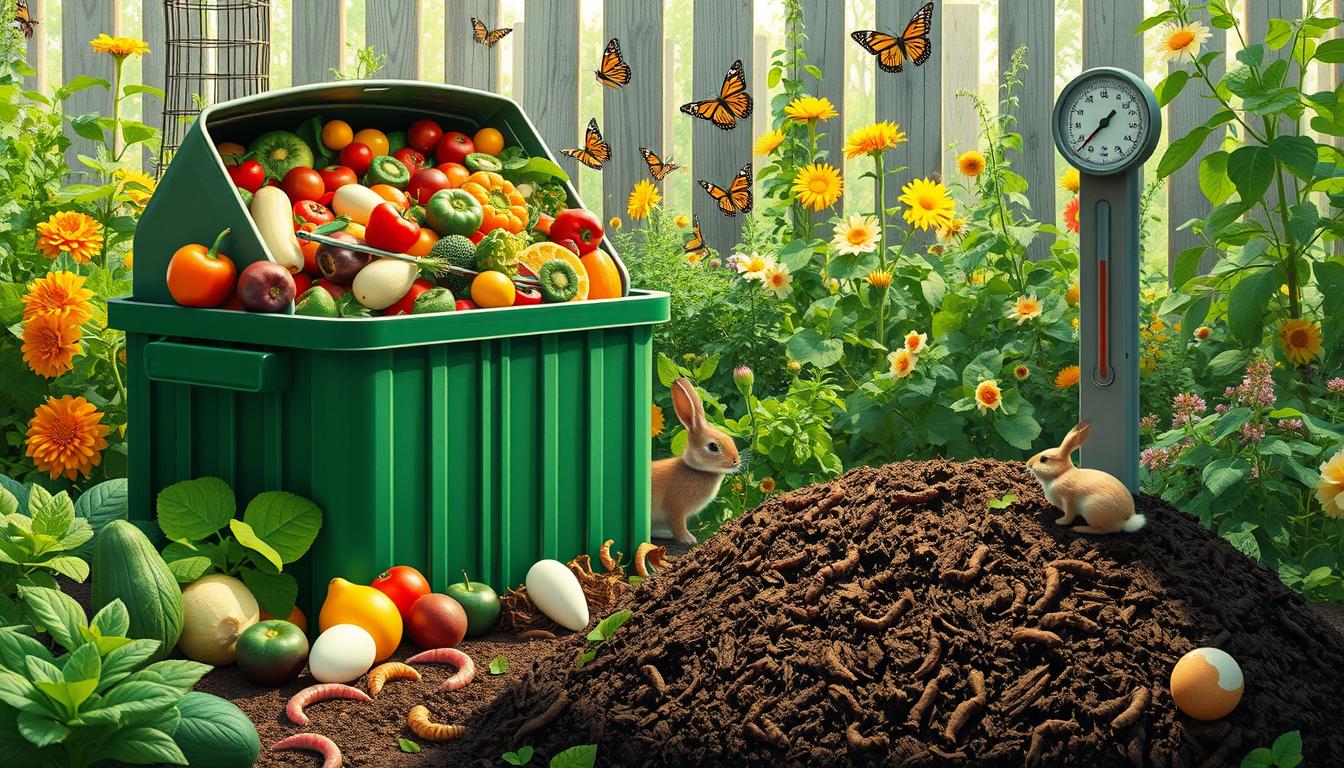I’m excited to share the importance of zero-waste composting tips. They help reduce food waste and support sustainable living. Composting at home is simple yet effective for the environment.
Zero-waste composting tips can greatly reduce landfill waste and save natural resources. Composting at home is easier than you might think. I’ll share tips and guidelines on sustainable living, including composting and reducing food waste.
Exploring zero-waste composting, I learn new ways to improve my skills and live sustainably. From composting at home to reducing food waste, I aim to share my knowledge. Let’s start this journey together and discover the benefits of zero-waste composting and sustainable living.
Understanding Zero-Waste Composting
Exploring composting, I see how crucial it is to cut down on food waste. Using eco-friendly compost methods helps us lessen our environmental impact. I’ll look into zero-waste composting, its perks, and how it’s different from regular composting.
Zero-waste composting aims to turn all organic stuff into soil. It’s great for reducing waste and using eco-friendly methods. This way, we help recycle organic waste and work towards a greener future.
What is Zero-Waste Composting?
Zero-waste composting turns food scraps and yard waste into compost. It needs a good grasp of composting and what can be composted. By doing this, we cut down landfill waste and make a valuable garden resource.
The Benefits of Zero-Waste Practices
Zero-waste composting has many benefits. Some key ones are:
- Less food waste and less landfill waste
- Soil rich in nutrients for gardens and plants
- Less water use and fewer synthetic fertilizers needed
- Supports recycling organic waste and a sustainable future
Key Differences from Traditional Composting
Zero-waste composting is different from traditional composting in waste handling. Traditional composting might throw away some stuff, but zero-waste composting tries to compost everything. This method cuts waste, supports eco-friendly composting, and aids in organic waste recycling.
Getting Started with Composting
To start composting, you need a system that works for you. A good kitchen composting guide is key. First, pick a compost bin that fits your space and needs. Think about your yard size and waste amount. You might need a small bin for indoors or a big one for outdoors.
A good guide will tell you what to compost. You can add food scraps, yard trimmings, and other organic stuff. For backyard composting, mix “green” materials like food waste and grass with “brown” materials like leaves and twigs. This mix is important for a healthy compost pile.
Choosing the Right Compost Bin
- Consider the size of your yard and the amount of waste you generate
- Opt for a bin with good aeration and drainage
- Look for a bin with a secure lid to keep pests out
By following these tips and creating a good guide, you’ll reduce waste and make nutrient-rich compost. Avoid mistakes like too much of one material or not turning it. With practice and patience, you’ll enjoy composting soon.

How to Maintain My Compost Bin
As I keep composting at home, I’ve found that keeping my compost bin in good shape is key. It’s important to make sure the composting process goes well. This way, the compost will be ready to use in my garden. By using sustainable living tips, I can make my compost bin work well for my garden and the planet.
To keep my compost bin in top shape, I need to watch the moisture, turn the compost, and know when it’s ready. Here are some tips to help me do this:
- Check the compost bin often to make sure it’s not too dry or too wet. It should be like a damp sponge.
- Turn the compost every few days to help it breathe and break down faster.
- Look for signs that the compost is ready, like a strong earthy smell and a dark, crumbly look.
By following these tips and composting at home, I can make compost that’s full of nutrients. This will help my garden grow strong. Remember, composting is a natural process that needs patience and regular care. With the right methods and sustainable living tips, I can enjoy composting’s benefits and help the environment.

Tips for Kitchen Composting
To cut down on food waste and make a valuable garden resource, you need a kitchen composting guide. A few simple tips can make a big difference. Start by collecting kitchen scraps in a special bin to keep them organized.
Knowing what scraps to add is key. Fruit and vegetable peels, tea bags, and eggshells are great for compost. They add nutrients and help balance your compost. Adding these to your compost routine reduces waste and enriches your garden.
Best Kitchen Scraps for Compost
- Fruit and vegetable peels
- Tea bags
- Eggshells
- Coffee grounds
Tips for Reducing Food Waste
Reducing food waste is vital in kitchen composting. Plan meals, use leftovers, and compost scraps to cut down waste. A guide can help you start and keep your compost bin healthy.

Storing Scraps Effectively
Storing scraps right is key for a healthy compost bin. Use a bin for scraps and add them often. This makes a nutrient-rich compost for your plants. Mix “green” and “brown” materials for a thriving compost.
Outdoor Composting Essentials
As I work towards a zero-waste lifestyle, I’ve learned how key outdoor composting is. It helps me cut down on waste and makes my garden soil better. First, I need to set up a compost area that works well.
When setting up my compost spot, I think about sunlight, drainage, and how easy it is to get to. I also plan what materials I’ll compost and how to use the space wisely. Composting is a big part of living sustainably and helps our planet.
Designing My Compost Area
To make a good compost area, I stick to a few important rules. These include:
- Choosing a spot that gets enough sunlight and drains well
- Using a compost bin or pile that breathes and is easy to get to
- Mixing “green” and “brown” materials for a balanced compost
Seasonal Considerations for Outdoor Composting
Seasons change, and so does my composting. In winter, I add more “brown” materials to keep moisture right. This way, my compost stays healthy and effective.
By using these composting tips and living zero-waste, I make a compost area that’s good for my garden and the planet.
Involving the Whole Family
Composting is a family activity that everyone can enjoy. Kids learn about taking care of the planet by helping with composting. Teach them how composting reduces waste and makes soil better for gardens.
Teaching Kids About Composting
Make composting fun for kids with hands-on tasks. Let them help turn the compost pile or sort food scraps. Watching the compost change helps them see how it works and their role in it.
Creating a Home Composting Routine
Make composting a regular part of your routine. Pick a time each day or week for the family to add scraps and check the compost. This builds a sense of teamwork and shows the value of reducing waste at home.

